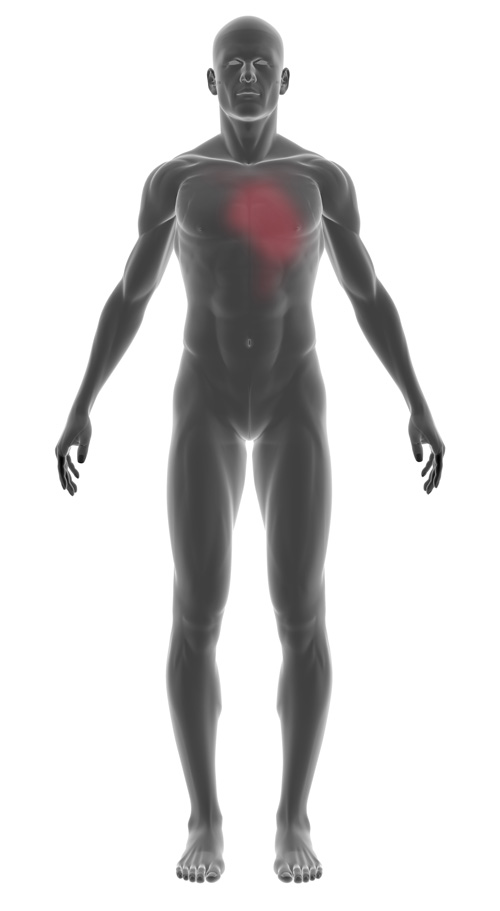High blood pressure
Incidence and causes
A normal blood pressure is vital. So that blood can flow through the blood vessels to the organs and tissues, it has to be under pressure. Two mechanisms ensure that this pressure arises: the rhythmic pumping of the heart and the resistance of the vessel walls.
When the heart muscle contracts and blood is propelled forwards, this results in higher blood pressure in the arteries. When the heart muscle then relaxes and the heart fills up again with blood, the blood pressure in the arteries gradually falls. However, it does not fall to zero because the elastic and muscular artery walls make sure the blood pressure between the pumping actions of the heart remains high enough to continue driving the blood through the circulation.
The rhythmic rise and fall of blood pressure is observed when measuring blood pressure. Two distinct blood pressure values are measured:
- Upper or systolic blood pressure. This occurs when the heart contracts and the pressure in the vessels is at its highest (systole).
- Lower or diastolic blood pressure. This occurs when the heart relaxes and the pressure in the vessels is at its lowest (diastole).
High blood pressure (known as “hypertension” in medical terminology) means that blood pressure is 140/90 mmHg or higher. High blood pressure still exists even if only one of the two levels is above this limit. Isolated high systolic pressure, in which only the upper value is increased, occurs mainly in elderly people. Three different degrees of severity of high blood pressure are defined:
| Systolic pressure | Diastolic pressure | |
| Mild hypertension | 140-159 mmHg | 90-99 mmHg |
| Moderate hypertension | 160-179 mmHg | 100-109 mmHg |
| Severe Hypertension | 180 mmHg and above | 110 mmHg and above |
In more than 90 per cent of patients with high blood pressure, no cause for their elevated levels can be found. This form is known as essential or primary hypertension.
For most patients, there are several factors which can disrupt the regulation of blood pressure and lead to essential hypertension. Among the most significant risk factors are age and genetic predisposition – neither of which can be influenced. Many people’s blood pressure rises after the age of 35, while in women it often does not rise until after the age of 50 or at the start of the menopause. However, factors that are associated with lifestyle and can hence be influenced also have a significant impact. These include being overweight, a high-salt diet, high alcohol consumption, lack of exercise, smoking, stress or certain drugs (e.g. the contraceptive pill). These factors can severely affect the natural regulation of blood pressure.
A cause of raised blood pressure, for example other diseases such as circulatory disorders of the kidneys or hormonal disturbances, can only be found in one twentieth of patients. This form of high blood pressure is known as secondary hypertension. If the causal disease is treated – for instance by surgical expansion of a narrowed renal artery – the high blood pressure will often disappear as well.
Symptoms of high blood pressure
Although high blood pressure usually causes no symptoms, it is very dangerous. If high blood pressure persists for months and years, it damages the heart and the blood vessels. In addition, it can have repercussions for the brain, the legs, kidneys and eyes. High blood pressure is therefore one of the major risk factors for cardiovascular disease.
Diagnosis
Blood pressure needs to be measured in order to detect hypertension. A single blood pressure measurement that is over 140/90 mmHg is not enough for the doctor to make a diagnosis. You can only be certain that someone has high blood pressure if at least three measurements within a few weeks have shown raised blood pressure levels. However, it is not easy to make a diagnosis in many patients because their blood pressure levels fluctuate widely or they are only too high in certain life situations. in these cases the doctor will have to spend more time on investigations. A common phenomenon is white coat hypertension or the white coat effect. This means a short-time rise in blood pressure that only happens at the doctor’s practice. This is due to the fact that many patients get rather nervous when they have to see their doctor. To differentiate white coat from “true” hypertension, patients can measure their blood pressure themselves at home or 24-hour blood pressure monitoring will be carried out.
Treatment options
The aim of treating high blood pressure is to lower it to a level below 140/90 mmHg. If you suffer from diabetes or kidney disease, your blood pressure should be reduced to below 130/80 mmHg. If you cannot achieve the target blood pressure within a few months by making lifestyle changes, you will have to take a blood pressure-lowering medication. If you are suffering from severe hypertension, diabetes or kidney disease, medication will be used at the very start of your treatment.


